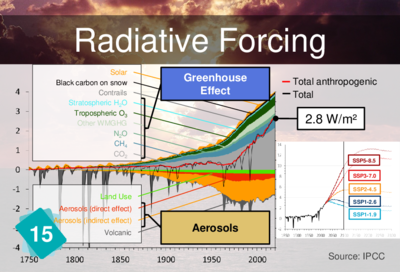En-en adult card 15 radiative forcing: Difference between revisions
(RCP internal link) |
mNo edit summary |
||
| Line 12: | Line 12: | ||
Anything that causes the Earth to move away freom this thermal equilibrium, whether natural (sun, volcanoes) or anthropogenic (aerosols, GHGs), is called radiative forcing. | Anything that causes the Earth to move away freom this thermal equilibrium, whether natural (sun, volcanoes) or anthropogenic (aerosols, GHGs), is called radiative forcing. | ||
Caution: the definition has been simplified for educational purposes. A rigorous definition would be as follows: "Radiative forcing is the measure of the imbalance between the energy that arrives every second on Earth and the energy that would leave if the temperature had remained fixed since 1750". As the earth's temperature has risen in the meantime, the delta between instantaneous heat exchanges has decreased. Similarly, in 2050, in the [[En-en adult card 15 radiative forcing#RCP|RCP]]<nowiki>2.6 scenario, the forcing will be {\displaystyle 2. | Caution: the definition has been simplified for educational purposes. A rigorous definition would be as follows: "Radiative forcing is the measure of the imbalance between the energy that arrives every second on Earth and the energy that would leave if the temperature had remained fixed since 1750". As the earth's temperature has risen in the meantime, the delta between instantaneous heat exchanges has decreased. Similarly, in 2050, in the [[En-en adult card 15 radiative forcing#RCP|RCP]]<nowiki>2.6 scenario, the forcing will be {\displaystyle 2.3W/m^{2}}{\displaystyle 2.3W/m^{2}}, but the temperature will have stabilised, meaning that the delta between incoming and outgoing energy will be zero.</nowiki> | ||
On the main graph, we can see the different components of the radiative forcing : | On the main graph, we can see the different components of the radiative forcing : | ||
Revision as of 18:46, 5 February 2021
Card #15: Radiative forcing
| Causes | Consequences | |

|
Radiative forcing represents the difference (caused by humans) between the energy that arrives on Earth each second and the energy that is released.
In the 5 th assessment report of IPCC, it is rated at (Watt per square meter).
Explanation
Together with the coccolithophores, this card is the one that makes the most impression on participants. It is important to explain it well. One way to play it down is to say that Radiative Forcing is just a measure.
Earth receives energy from the Sun and radiates it back to space in the form of infrared. Normally it is in thermal equilibrium and its temperature is constant.
Anything that causes the Earth to move away freom this thermal equilibrium, whether natural (sun, volcanoes) or anthropogenic (aerosols, GHGs), is called radiative forcing.
Caution: the definition has been simplified for educational purposes. A rigorous definition would be as follows: "Radiative forcing is the measure of the imbalance between the energy that arrives every second on Earth and the energy that would leave if the temperature had remained fixed since 1750". As the earth's temperature has risen in the meantime, the delta between instantaneous heat exchanges has decreased. Similarly, in 2050, in the RCP2.6 scenario, the forcing will be {\displaystyle 2.3W/m^{2}}{\displaystyle 2.3W/m^{2}}, but the temperature will have stabilised, meaning that the delta between incoming and outgoing energy will be zero.
On the main graph, we can see the different components of the radiative forcing :
in the upper part, the warming effects
in the lower part, the cooling effects
The greenhouse effect (CO2 + Other WMGHG + Trop O3) represents a positive forcing of {\displaystyle 3,1W/m^{2}} . It is therefore in the upper part of the graph.
Aerosols (Aer - Rad Int. + Aer - Cld Int.) have a cooling effect and are therefore in the lower part of the graph.
For more details on this graph, see the Radiative Forcing fact sheet.
The secondary graph represents the radiative forcing over two and a half centuries (history and projections). In the 5th IPCC report, the radiative forcing is {\displaystyle 2.3W/m^{2}}. The values of the forcing in 2100 gave their name to the IPCC scenarios (RCP 2.6, RCP 4.5 etc.). The colours of these scenarios can be found in the graphs of maps n°5, 11, 15, 21, 22 and 24.
For more details on this graph, see the fact sheet on PCR scenarios.
